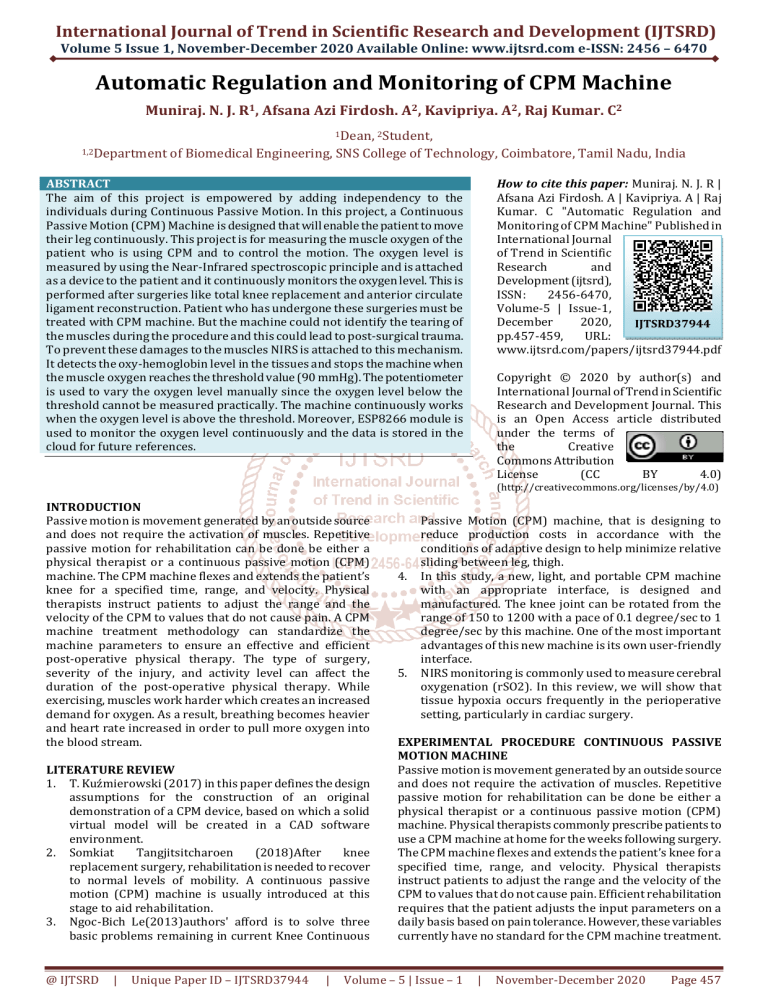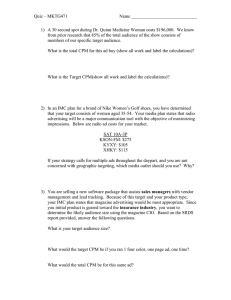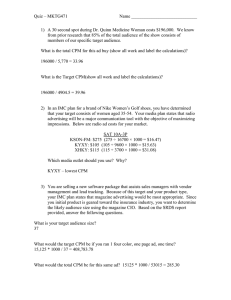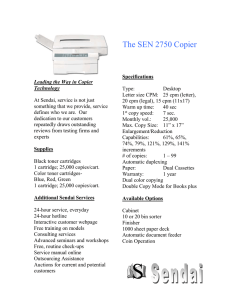
International Journal of Trend in Scientific Research and Development (IJTSRD) Volume 5 Issue 1, November-December 2020 Available Online: www.ijtsrd.com e-ISSN: 2456 – 6470 Automatic Regulation and Monitoring of CPM Machine Muniraj. N. J. R1, Afsana Azi Firdosh. A2, Kavipriya. A2, Raj Kumar. C2 1Dean, 2Student, 1,2Department of Biomedical Engineering, SNS College of Technology, Coimbatore, Tamil Nadu, India How to cite this paper: Muniraj. N. J. R | Afsana Azi Firdosh. A | Kavipriya. A | Raj Kumar. C "Automatic Regulation and Monitoring of CPM Machine" Published in International Journal of Trend in Scientific Research and Development (ijtsrd), ISSN: 2456-6470, Volume-5 | Issue-1, December 2020, IJTSRD37944 pp.457-459, URL: www.ijtsrd.com/papers/ijtsrd37944.pdf ABSTRACT The aim of this project is empowered by adding independency to the individuals during Continuous Passive Motion. In this project, a Continuous Passive Motion (CPM) Machine is designed that will enable the patient to move their leg continuously. This project is for measuring the muscle oxygen of the patient who is using CPM and to control the motion. The oxygen level is measured by using the Near-Infrared spectroscopic principle and is attached as a device to the patient and it continuously monitors the oxygen level. This is performed after surgeries like total knee replacement and anterior circulate ligament reconstruction. Patient who has undergone these surgeries must be treated with CPM machine. But the machine could not identify the tearing of the muscles during the procedure and this could lead to post-surgical trauma. To prevent these damages to the muscles NIRS is attached to this mechanism. It detects the oxy-hemoglobin level in the tissues and stops the machine when the muscle oxygen reaches the threshold value (90 mmHg). The potentiometer is used to vary the oxygen level manually since the oxygen level below the threshold cannot be measured practically. The machine continuously works when the oxygen level is above the threshold. Moreover, ESP8266 module is used to monitor the oxygen level continuously and the data is stored in the cloud for future references. Copyright © 2020 by author(s) and International Journal of Trend in Scientific Research and Development Journal. This is an Open Access article distributed under the terms of the Creative Commons Attribution License (CC BY 4.0) (http://creativecommons.org/licenses/by/4.0) INTRODUCTION Passive motion is movement generated by an outside source and does not require the activation of muscles. Repetitive passive motion for rehabilitation can be done be either a physical therapist or a continuous passive motion (CPM) machine. The CPM machine flexes and extends the patient’s knee for a specified time, range, and velocity. Physical therapists instruct patients to adjust the range and the velocity of the CPM to values that do not cause pain. A CPM machine treatment methodology can standardize the machine parameters to ensure an effective and efficient post-operative physical therapy. The type of surgery, severity of the injury, and activity level can affect the duration of the post-operative physical therapy. While exercising, muscles work harder which creates an increased demand for oxygen. As a result, breathing becomes heavier and heart rate increased in order to pull more oxygen into the blood stream. LITERATURE REVIEW 1. T. Kuźmierowski (2017) in this paper defines the design assumptions for the construction of an original demonstration of a CPM device, based on which a solid virtual model will be created in a CAD software environment. 2. Somkiat Tangjitsitcharoen (2018)After knee replacement surgery, rehabilitation is needed to recover to normal levels of mobility. A continuous passive motion (CPM) machine is usually introduced at this stage to aid rehabilitation. 3. Ngoc-Bich Le(2013)authors' afford is to solve three basic problems remaining in current Knee Continuous @ IJTSRD | Unique Paper ID – IJTSRD37944 | 4. 5. Passive Motion (CPM) machine, that is designing to reduce production costs in accordance with the conditions of adaptive design to help minimize relative sliding between leg, thigh. In this study, a new, light, and portable CPM machine with an appropriate interface, is designed and manufactured. The knee joint can be rotated from the range of 150 to 1200 with a pace of 0.1 degree/sec to 1 degree/sec by this machine. One of the most important advantages of this new machine is its own user-friendly interface. NIRS monitoring is commonly used to measure cerebral oxygenation (rSO2). In this review, we will show that tissue hypoxia occurs frequently in the perioperative setting, particularly in cardiac surgery. EXPERIMENTAL PROCEDURE CONTINUOUS PASSIVE MOTION MACHINE Passive motion is movement generated by an outside source and does not require the activation of muscles. Repetitive passive motion for rehabilitation can be done be either a physical therapist or a continuous passive motion (CPM) machine. Physical therapists commonly prescribe patients to use a CPM machine at home for the weeks following surgery. The CPM machine flexes and extends the patient’s knee for a specified time, range, and velocity. Physical therapists instruct patients to adjust the range and the velocity of the CPM to values that do not cause pain. Efficient rehabilitation requires that the patient adjusts the input parameters on a daily basis based on pain tolerance. However, these variables currently have no standard for the CPM machine treatment. Volume – 5 | Issue – 1 | November-December 2020 Page 457 International Journal of Trend in Scientific Research and Development (IJTSRD) @ www.ijtsrd.com eISSN: 2456-6470 Therefore, there is a need to determine an effective physical therapy treatment methodology using a CPM machine. A CPM machine treatment methodology can standardize the machine parameters to ensure an effective and efficient post-operative physical therapy. A physical therapy treatment methodology can have several dependent factors The type of surgery, severity of the injury, and activity level can affect the duration of the post-operative physical therapy. The patient characteristics (e.g. gender, size, and weight) can also be contributing factors in determining the range of motion or velocity of CPM. The duration of the treatment, the range of motion, and the knee flexion velocity are the parameters that can change in order to optimize the physical therapy treatment. CONCLUSION Many basic fundamental researches and development challenges remain in linear actuator development, NIR Sensor development, control and to assemble in a disciplined manner. This project has focussed on the NIR Sensor based automatic control of the CPM Machine when the muscle oxygen level gets decreased during the continuous movement (exercises) the NIR Sensor senses the level and if it is below the threshold value(90mm/Hg) the machine automatically stops else the machine runs continuously. The stepper motor is used to drive the CPM Machine which is connected to the Arduino board. The L293Driver module is used to protect the back EMF from the motor. Thus the analysis of the patients are addressed in the command windows, can be seen in our mobile via internet. CONSTRUCTION The CPM device has two 4-bar linkages similar to that of the commercially available devices. A linear slider driven by a stepper motor controls the motion of the slider-rocker linkage. The motion of the double-rocker linkage controls the angle of knee flexion. The device is capable of 120 degrees of rotation at angular velocities from 30 to 750 degrees per minute. The device is made almost entirely of 6061-T6 aluminium. FUTURE WORK The musical system can be placed for the children in the CPM machine while exercising so the child will be more enthusiastic in doing it without any hesitation. It may be made wearable device for our convenience. It can be worn while exercising also in future. The linear slider came equipped with a 24V stepper motor. The device has closed-loop control with a constant power supply. The output current of the power supply can adjust the speed of the device. In order to change rotational direction of the linear slider (i.e., flexion/extension), the direction of current can be reversed by switching the leads on the power supply. [2] Amalakanti M. D., Mohan RaoPentakota M.D.,(2016), “Pulse Oximetry Over estimates Oxygen Saturation in COPD”,Vol.No.61,pp.424-426. [3] Aristides I., Cruz Jr., M.D., Michael S. Laidlaw, (2015), “Invasive Compartment Pressure Testing for Chronic Exertional Compartment Syndrome”, The American Journal of Orthopaedics, pp.E384-E389. [4] Bergqvist and Pia(2015), “Preventing Hypoxia”, Vol.44, pp.24-27. [5] Brain Benchoff (2014),”New Chip Alert: The ESP8266 WiFi Module, Vol.No.43, pp.55. [6] Cope M., Delpy D. T. , S. Wray, J. S. Wyatt and E. O. R. Reynolds(1989), “A CCD spectrometer to quantitate the concentration of chromophores in living tissue utilizing the absorption peak of water at 975 nm”, Vol. No. 248, pp.33–40. [7] David Kushner (2011), "The Making of Arduino", IEEE Spectrum. [8] Dolan, Alexander, (2015),”Potentiometer History and Technology”, Journal of sensor history, Vol. No.2, pp.232-243. [9] Hernando Barragán (2016), "The Untold History of Arduino", arduinohistory.github.io. [10] JianLiub, YuFua, (2015), “System design for wearable blood oxygen saturation and pulse measurement device,” 6th International Conference on Applied Human Factors and Ergonomics”,pp.1187 – 1194. [11] Justin Lahart (2009), "Taking an Open-Source Approach to Hardware". The Wall Street Journal. Vol. No.42.pp.348-351. [12] Lewis, P. B., McCarty, L. P., Kang, R. W., Coole, B. J., (2006),”Basic Science and Treatment Options for The CPM Machine is derived by the stepper motor in a controlled motion. The NIR Sensor is connected to the patients in the toe, which is connected to the Arduino board. The L293driver module is connected to the Arduino with the stepper motor which is connected to the CPM machine. The threshold is set before attaching the sensor to the patients and when the NIR Sensor senses the muscle o2 level in the patient while exercising, if the patient analysed below the threshold level the CPM Machine automatically stops else the machine runs continuously. Potentiometer is used for the voltage divider and control the speed of the stepper motor. RESULT AND DISCUSSION The CPM Machine is designed by using the aluminium shaft materials. The stepper motor is connected to the CPM Machine and control of the stepper motor is by using the L293 Driver module. The movement of the legie., forward and backward by changing the directions of the stepper motor in clockwise and anticlockwise direction. With the help of NIR Sensor, the muscle oxygen level is continuously measured. The threshold value is fixed by arduino program. These results are viewed in the monitor by using ESP8266 module. @ IJTSRD | Unique Paper ID – IJTSRD37944 | REFERENCES [1] Allan, Alasdair (2015), "Arduino Wars: Group Splits, Competing Products Revealed", makezine.com, Maker Media, Inc., Vol.No.45, pp.451. Volume – 5 | Issue – 1 | November-December 2020 Page 458 International Journal of Trend in Scientific Research and Development (IJTSRD) @ www.ijtsrd.com eISSN: 2456-6470 Articular Cartilage Injuries”, Journel of Orthopaedics & Sports Physical Therapy pp.823 – 829. [13] [14] Liptak, Bela G., (2005),”Instrument Engineers”, Handbook: process control and optimization, CRC Press, Vol.No.44, pp.2464. Mendelson Y., Duckworth R. J., Comtois G. (2006), ” A Wearable Reflectance Pulse Oximeter for Remote Physiological Monitoring”, Proceedings of the 28th IEEE EMBS Annual International Conference New York City, USA, pp.912-915. [15] Muehlemann T., Haensse D., Wolf M., (2008),” Wireless miniaturized in vivo near infrared imaging”, Opt. Expr, Vol. No. 16(14), pp.10323–10330. [16] Murković I., Steinberg M. D., Murković B., (2003),” Sensors in neonatal monitoring: Current practice and future trends, Technology and Health Care”, IOS Press, Vol. No. 11, pp. 399–412. [17] O’Driscoll S. W., Giori, N. J., (2000), “Continuous passive motion (CPM): Theory and principles of clinical application”, Journal of Rehabilitation Research and Development, Vol. No. 37(2), pp.179188. [18] Schmidt, (2011),"Arduino: A Quick Start Guide", The Pragmatic Bookshelf, Vol.No.23, pp.201. [19] Schutz, (2012), “Oxygen Saturation Monitoring by Pulse Oxymetry”, American association of critical care nurses, Vol.No.33, pp.44-51. @ IJTSRD | Unique Paper ID – IJTSRD37944 | [20] Skov L., Pryds O. and Greison G. (1999), “Estimating cerebral blood flow in newborn infants; Comparison of near infrared spectroscopy and 133 Xenon clearance”, Vol.No.30, pp.570-573. [21] Smith, (2018), "Differences between the Arduino Uno Revision 2 and Revision 3", startingelectronics.org, Vol.No.12, pp.23. [22] Thompson, Julie, (2008), “Design, Construction and Validation of a Cadaver Knee Motion Testing Device” pp.309 – 324. [23] VanBeekvelt, B. G. M. VanEngelen, R. A. Weversand W. J. M. Colier, (2003), “Invivo quantitative near-infrared spectroscopy in skeletal muscle during incremental isometric handgrip exercise”, Clin. Physiol. Funct. Imaging Vol.No.22, pp.1-8. [24] West, John B., Lippincott Williams and Wilkins,(2012) “Pulmonary pathophysiology: The essentials (8th ed.), Vol. No. 55(3),pp.688-98. [25] Wilson, D. R., Feikes, J. D., Zavatsky, A. B., O’Connor, J. J. (2000), “The components of passive knee movement are coupled to flexion angle”, Journel of Biomechanics, Vol. No.33, pp.465 - 473. [26] Wolf M., Ferrari M. and Quaresima V. (2007), “Progress of near-infrared spectroscopy and topography for brain and muscle clinical applications”, Journal of Biomedical Optics, Vol. No.12 (6), pp.06210414. Volume – 5 | Issue – 1 | November-December 2020 Page 459



